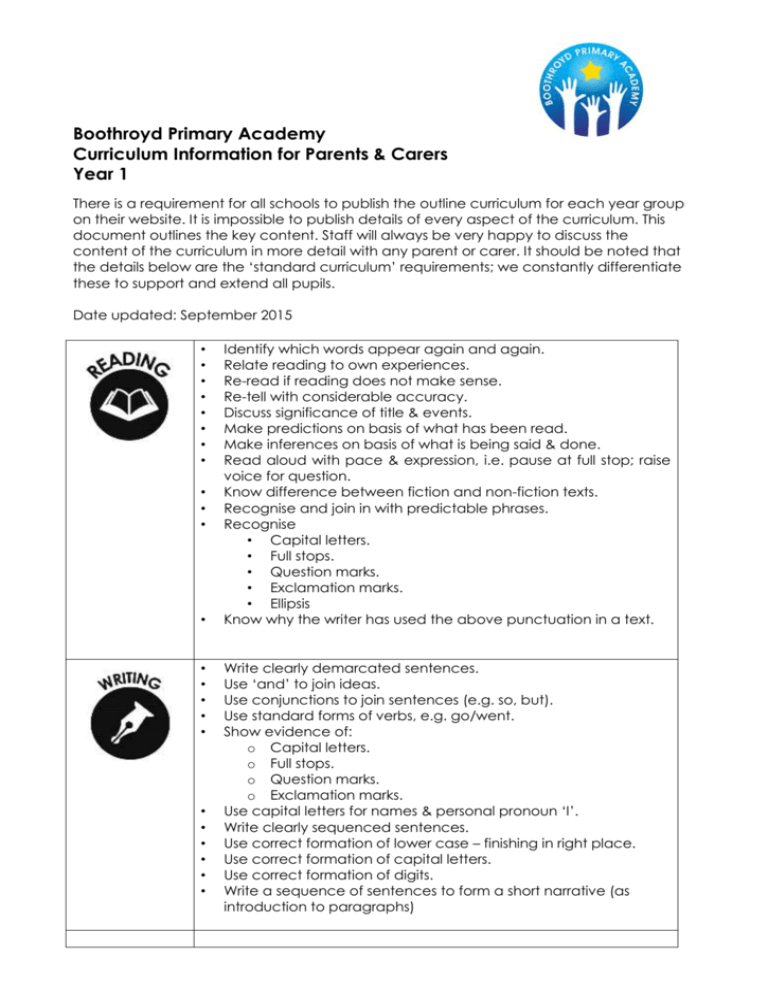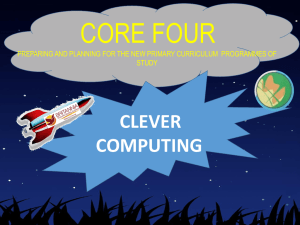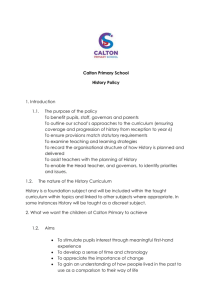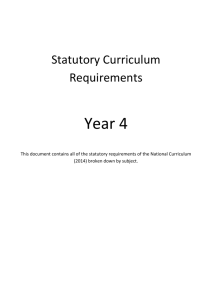Year 1 curriculum information for parents
advertisement

Boothroyd Primary Academy Curriculum Information for Parents & Carers Year 1 There is a requirement for all schools to publish the outline curriculum for each year group on their website. It is impossible to publish details of every aspect of the curriculum. This document outlines the key content. Staff will always be very happy to discuss the content of the curriculum in more detail with any parent or carer. It should be noted that the details below are the ‘standard curriculum’ requirements; we constantly differentiate these to support and extend all pupils. Date updated: September 2015 • • • • • • • • • • • • • • • • • • • • • • • Identify which words appear again and again. Relate reading to own experiences. Re-read if reading does not make sense. Re-tell with considerable accuracy. Discuss significance of title & events. Make predictions on basis of what has been read. Make inferences on basis of what is being said & done. Read aloud with pace & expression, i.e. pause at full stop; raise voice for question. Know difference between fiction and non-fiction texts. Recognise and join in with predictable phrases. Recognise • Capital letters. • Full stops. • Question marks. • Exclamation marks. • Ellipsis Know why the writer has used the above punctuation in a text. Write clearly demarcated sentences. Use ‘and’ to join ideas. Use conjunctions to join sentences (e.g. so, but). Use standard forms of verbs, e.g. go/went. Show evidence of: o Capital letters. o Full stops. o Question marks. o Exclamation marks. Use capital letters for names & personal pronoun ‘I’. Write clearly sequenced sentences. Use correct formation of lower case – finishing in right place. Use correct formation of capital letters. Use correct formation of digits. Write a sequence of sentences to form a short narrative (as introduction to paragraphs) • • • • • • • • • • • • • Count to & across 100, forwards & backwards from any number. Read & write numbers to 20 in digits & words. Read & write numbers to 100 in digits. Say 1 more/1 less to 100. Count in multiples of 1, 2, 5 & 10. Know bonds to 10 by heart. Use bonds & subtraction facts to 20. Add & subtract 1 digit & 2 digit numbers to 20, including zero. Solve simple multiplication & division with apparatus & arrays. Recognise half and quarter of object, shape or quantity. Sequence events in chronological order. Use language of day, week, month and year. Tell time to hour & half past. Working Scientifically Pupils should be taught to: Ask simple questions and recognise that they can be answered in different ways. Observe carefully, using simple equipment. Identify and classify. Use their observations and ideas to suggest answers to their questions. Gather and record data to help in answering questions. Plants Pupils should be taught to: Identify and name a variety of common wild and green plants, including deciduous and evergreen trees. Identify and describe the basic structure of a variety of common flowering plants, including trees. Animals, including humans Pupils should be taught to: Identify and name a variety of common animals, including fish, amphibians, reptiles, birds and mammals. Identify and name a variety of common animals that are carnivores, herbivores and omnivores. Describe and compare the structure of a variety of common animals (fish, amphibians, reptiles, birds and mammals, including pets). Identify, name, draw and label the basic parts of the human body and say which part of the human body is associated with each sense. Uses of everyday materials Pupils should be taught to: Distinguish between an object and the materials from which it is made. Identify and name a variety of everyday materials, including wood, plastic, glass, metal, water and rock. Describe the simple physical properties of a variety of everyday materials. Compare and group together a variety of everyday materials on the basis of their simple physical properties. Seasons Name the seasons and characteristics related to each season and how they change. Pupils should be taught to: understand what algorithms are; how they are implemented as programs on digital devices; and that programs execute by following precise and unambiguous instructions. create and debug simple programs . use logical reasoning to predict the behaviour of simple programs use technology purposefully to create, organise, store, manipulate and retrieve digital content. recognise common uses of information technology beyond school . use technology safely and respectfully, keeping personal information private; identify where to go for help and support when they have concerns about content or contact on the internet or other online technologies. Pupils should be taught about: changes within living memory. Where appropriate, these should be used to reveal aspects of change in national life. events beyond living memory that are significant nationally or globally [for example, the invention of the steam engine and railways or events commemorated through festivals or anniversaries]. the lives of significant individuals in the past who have contributed to national and international achievements. Some should be used to compare aspects of life in different periods [for example, Elizabeth I and Queen Victoria, Christopher Columbus and Neil Armstrong, William Caxton and Tim Berners-Lee, Pieter Bruegel the Elder and LS Lowry, Rosa Parks and Emily Davison, Mary Seacole and/or Florence Nightingale and Edith Cavell]. significant historical events, people and places in their own locality. Pupils should be taught : Locational knowledge Identify the four countries making up the United Kingdom. Name some of the towns and cities in the United Kingdom. Point out where the equator, north pole and south pole are on a globe or atlas. Physical geography Know their address. Explain the main features of a hot and cold place. Describe a locality using words and pictures. Explain how the weather changes with each season. Name key features associated with a town or village eg church, farm, shop, house, factory, detached house, semi-detached house, terraced house. Human geography Explain why they would wear different clothes at different times of the year. Say something about the people who live in hot and cold places. Explain what they might wear if they lived in a very hot or very cold place. Geographical enquiry Say what they like about their locality. Sort things they like and don’t like. Answer some questions using different resources, such as books, the internet and atlases. Think of a few good questions to ask about a locality. Answer questions about the weather. Keep a weather chart and answer questions about it. Pupils should be taught: to use a range of materials creatively to design and make products. to use drawing, painting, printing, textiles, collage and sculpture to develop and share their ideas, experiences and imagination. to develop a wide range of art and design techniques in using colour, pattern, texture, line, shape, form and space. about the work of a range of artists, craft makers and designers, describing the differences and similarities between different practices and disciplines, and making links to their own work. Design design purposeful, functional, appealing products. generate, develop, model and communicate their ideas through talking, drawing, and, where appropriate, information and communication technology. Make select from and use a range of tools and equipment to perform practical tasks [for example, cutting, shaping, joining and finishing] select from and use a wide range of materials and components, including construction materials, modelling clay, ingredients and textiles. Evaluate explore and evaluate a range of existing products. evaluate their ideas and products against design criteria. Technical knowledge build structures, exploring how they can be made stronger, stiffer and more stable. explore and use mechanisms [for example, levers and sliders], in their products. Pupils should be taught to: use their voices expressively and creatively by singing songs and speaking chants and rhymes. play tuned and untuned instruments musically. listen with concentration and understanding to a range of highquality live and recorded music. experiment with, create, select and combine sounds using the inter-related dimensions of music. Pupils should be taught to: master basic movements including running, jumping, throwing and catching, as well as developing balance, agility and coordination, and begin to apply these in a range of activities. participate in team games, developing simple tactics for attacking and defending. perform dances using simple movement patterns.



![afl_mat[1]](http://s2.studylib.net/store/data/005387843_1-8371eaaba182de7da429cb4369cd28fc-300x300.png)





